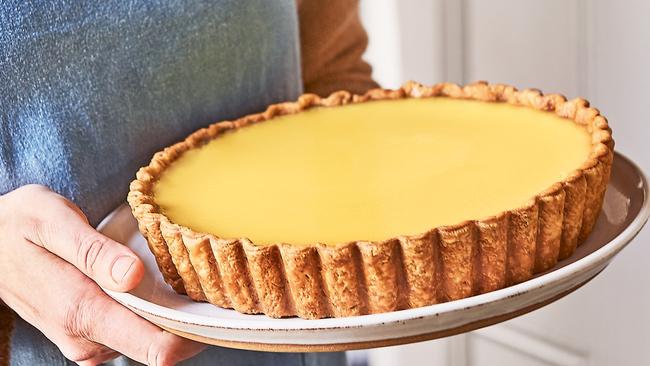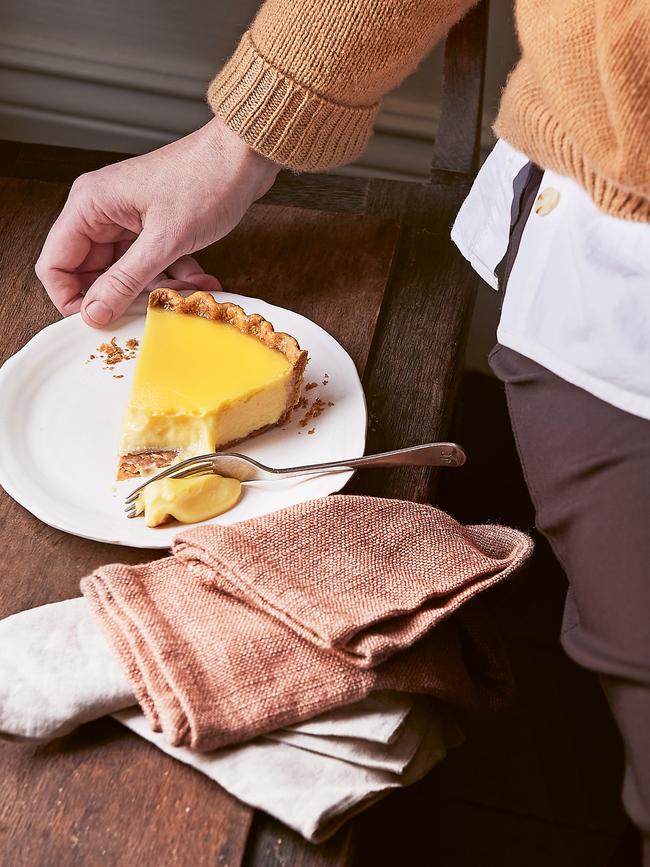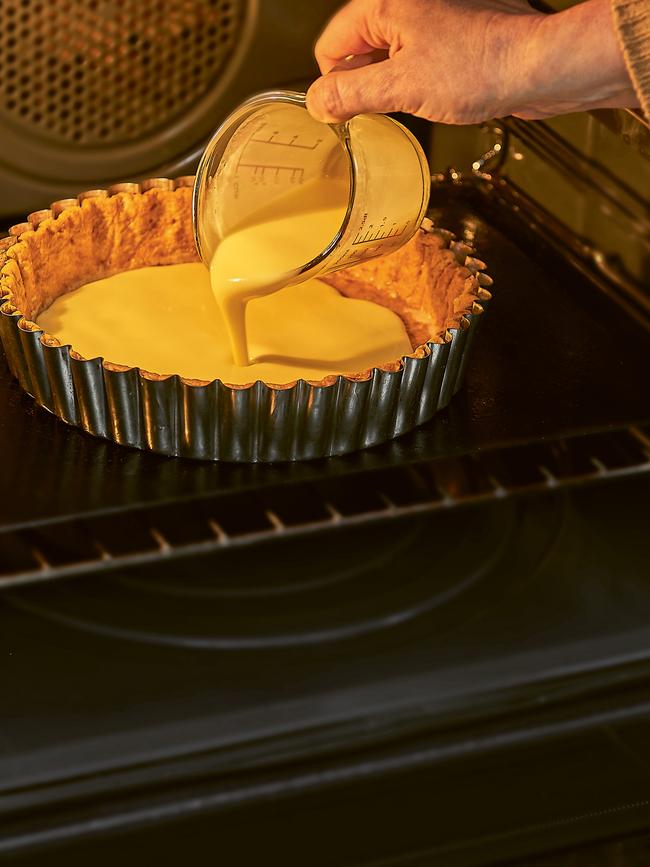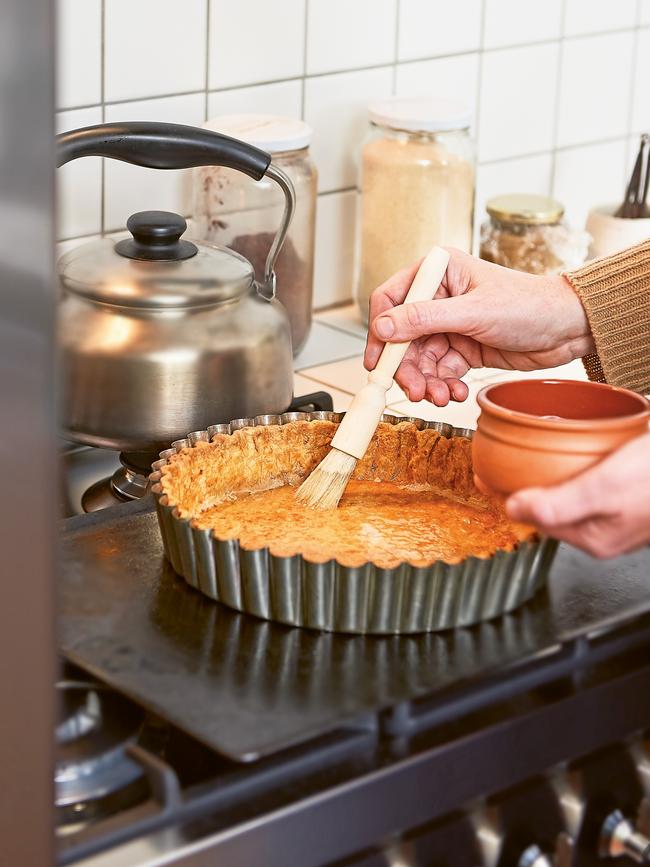Natalie Paull’s lemon cream tart is a thing of beauty
I bake this when I have good lemons. Good lemons, to me, are misshapen, bumpy-skinned, aroma-before-appearance fruit from a back yard or organic grocer.

I bake this when I have good lemons. Good lemons, to me, are misshapen, bumpy-skinned, aroma-before-appearance fruit from a back yard or organic grocer. I like assertive and sour varieties like eureka or lisbon. I adore meyer lemons and counter their submissive sourness with less sugar.
In my humble baking opinion, low-rise lemon tarts are more pleasing because the relationship of delicate lemony custard and buttery cradle crust is balanced. To reverse this ratio and lean into lemon, choose a deeper and narrower tin. Follow your tart.
By the way, sightly browned overcooked lemon tarts can be salvaged. Get the tart into the fridge as soon as possible. When it is chilled to just cold, spread the top with billowy whipped cream and a fresh grating of lemon zest. Hello, lemon cream pie!
I have given you a little extra filling in this recipe in case you need it. Eat with cream.


Lemon cream tart
- 1 × brisee butter crust (see below) rolled into a 24cm × 4cm deep tart tin, blind baked
Lemon custard filling
- 6 eggs
- 1 egg yolk (reserve the white)
- 4 lemons
- 240g caster sugar
- 300ml cream
- ¼ teaspoon sea salt flakes
Method
- Place 5cm of water in a saucepan, place on the stovetop and bring to a low simmer. Choose a stainless-steel bowl to sit on top that is slightly wider than the pan so the bottom of the bowl won’t touch the water.
- Into that bowl (before placing it over the saucepan), place eggs and extra yolk. Place the egg white in a separate small bowl and lightly whisk to break it up; you’ll use this later.
- Finely grate the zest of 1 lemon, then juice all the lemons. Strain until you have 180ml of juice. Add the zest to the juice and set aside.
- Add the sugar to the egg bowl and hand whisk together until combined, but not frothy. Whisk in the lemon juice and zest, then whisk in the cream and salt until fully combined.
- Place the bowl on the double boiler, gently whisking often until the mix reaches 60C (takes around 10 minutes). The custard will get a little thicker, the foam will dissipate and the custard will turn a more sunshiny yellow.
- Remove the bowl from the heat and pour the filling through a fine sieve into a measuring jug. Discard the zest. If you have a little froth on the top you can spoon this off, but it’s not vital. Set the filling aside at room temperature while you prepare the crust.
- Preheat your oven to 120C. Place the blind-baked crust, still in the tin, on a shallow baking tray. If there are any large cracks or dipped sides, massage a little leftover dough to a soft paste consistency and gently patch any large fissures. Brush the inside of the tart with the whisked egg white.
- Return the baking tray and crust to the oven and bake for 3 minutes to seal the crust before filling. With the tart still in the oven, and your eye on where the crust edge is lowest, carefully and slowly pour the custard into the crust to fill as far as you can. If your jug, when tilted, is too big for the oven, switch to a smaller cup to scoop in the last of the mix. Don’t overfill, or the filling will cascade between the crust and tin.
- Bake for 40-50 minutes until there is a 7cm-diameter centre of quivering, thick, shaky filling in the middle of the tart. This wobbly centre will continue to cook and set firmer upon cooling. Turn the oven off, keep the door closed and leave for 5 minutes. The wobbly centre should have set firm and feel like the most delicate bouncy custard trampoline when touched lightly with your fingertips. Leave another 5 minutes if you think it’s still a bit too wobbly.
- Remove from the oven and allow to cool at room temperature for at least 1 hour (longer for deeper tarts) before cutting the first slice. You can also chill to hasten the setting (and eating). Serves 6-8


Brisee butter crust
Ingredients
- 175g plain flour
- 130g unsalted butter, cold and sliced into small tiles
- ¼ teaspoon sea salt
- 60ml iced water
Method
- Lightly toss the flour, butter tiles and salt in a wide mixing bowl and chill for 30 minutes. Then break and flake the butter pieces between your fingers while tossing with the flour until the butter pieces are the size of a thick thumbnail. Scatter the water over the flour/butter mix and lightly toss through. Knead until firm.
- Wrap loosely in plastic wrap and firmly squeeze into a flat disc. This will be the final step in bringing the dough together; it will feel like quite stiff playdough. Chill dough overnight to hydrate fully.
- To roll, bring the dough to cool and pliable temperature (15-30 minutes at room temperature) and place on a lightly floured surface. Press the dough out a little with the palm of your hand to ease it into the start of rolling. This helps to prevent large cracks. Give the dough one or two short pressured rolls with the pin before lifting and moving the dough 90 degrees, making the rolls longer as the dough circle widens. Dust underneath at regular intervals to prevent sticking.
- Freeze for at least 1 hour before blind baking.
- To blind bake, preheat the oven to 200C. Cover the frozen dough with a large piece of foil (dull side down), tucking it snugly into the corner of the tin. Fill the foil liner with about 750g caster sugar, then place the tart shell on a heavy baking tray. Reduce heat to 170C and bake for 1 hour until the crust base is a fully realised tan colour. If the base crust is still a little pale, remove the foil and return to the oven for 5 minutes, watching closely until the crust base reaches peak crispness and brownness.
Makes enough for a 24cm tart
This is an edited extract from Beatrix Bakes: Another Slice by Natalie Paull (Hardie Grant, $50). Photography: Rochelle Eagle

To join the conversation, please log in. Don't have an account? Register
Join the conversation, you are commenting as Logout